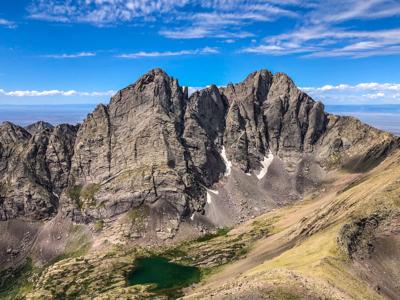Fourteener climbing in Colorado is a high-risk activity that can result in serious injury and death, even among the most experienced.
On Sunday, September 27, the body of a male climber was found in the area of Crestone Needle – a Sangre de Cristo Range peak that's considered to be one of Colorado's most dangerous 14,000-plus-foot mountains. The body was later identified as Jeff Deardorff, an experienced Colorado climber that had summited many of the state's highest peaks.

Search and rescue personnel on Crestone Needle during the early morning hours. Photo Credit: Custer County SAR (via Facebook).
According to Custer County Search and Rescue, Deardorff was last seen on the 14,197-foot summit of the Crestone Needle on Friday, September 25. Search and rescue teams were notified that the man was missing late on Saturday night.
The search for Deardorff was started at 3 AM on Sunday, with spotters locating him at approximately 1 PM. Upon reaching the Deardorff, it was determined he was deceased.
The recovery process was quite complicated, not completed until after 9 PM. It involved lowering Deardorff's body 100 feet down the mountain to a point where it was safe for a helicopter to extract it.

A search and rescue team member moves down technical terrain during the mission to find and recover a missing hiker on Crestone Needle. Photo Credit: Custer County SAR (via Facebook).
According to a report from CBS Denver, Deardorff took a fatal fall during his descent from the summit.
Images from the scene of the recovery show snow present on some parts of the mountain, while other portions of trail and slope remain dry. It is unclear if slick conditions played a factor in the fatal accident.

A search and rescue team member on snow terrain during the mission. Photo Credit: Custer County SAR (via Facebook).

Crews operate on snowy terrain. Photo Credit: Custer County SAR (via Facebook).
Custer County Search and Rescue posted a heartfelt message on Facebook about the incident:
"We cannot begin to imagine the tragic heartbreak this places on Mr. Deardorff's family and friends. To further that, the Colorado hiking community as a whole.
As an all volunteer organization, Custer County Search and Rescue understands and fully respects the inherent dangers, magnitude and impact of the jobs we perform. The sadness of an outcome like this is not lost on the rescuers, and is felt across our organization."
Crestone Needle is one of the state's most dangerous and most challenging fourteeners. The standard route to the top is a class three hike with 4,400 feet of vertical gain and 12 miles of distance round trip. The Crestone Needle is also on one side of the infamous Crestone Traverse, which links the mountain to Crestone Peak across a dangerous class five route. The terrain on this mountain is exposed, loose, and technical. In some cases, a single slip could mean death.
If you're off to climb any of Colorado's fourteeners, it's important that you're extremely aware of the risks and that you heavily research the route beforehand. Be aware of the weather and plan ahead by determining route conditions before your hike. During the spring and fall, lingering snow from past storms can stick around for a long time thanks to frigid high-elevation temperatures.
Always be prepared for a worst case scenario. Consider bringing along an emergency communication device, such as the Garmin inReach and always tell people where you're headed and when you'll be back, including what specific route you'll be on.
It's impossible to remove all of the risk, even with the right gear and ample experience. However, taking every effort possible to minimize the risk can be the difference between life or death.
Condolences go out to the friends and family of Jeff Deardorff during this difficult time. Thanks goes out to the many organizations involved in this search and recovery mission, including Custer County Search and Rescue, the Colorado Search and Rescue Association, Western Mountain Rescue Team, Flight for Life, Saguache County Search and Rescue, Custer County Sheriff's Department, and dispatchers at Fremont County Communications.
If you're looking to help support Colorado search and rescue, consider purchasing something called a CORSAR card. Learn more about that here.













(0) comments
Welcome to the discussion.
Log In
Keep it Clean. Please avoid obscene, vulgar, lewd, racist or sexually-oriented language.
PLEASE TURN OFF YOUR CAPS LOCK.
Don't Threaten. Threats of harming another person will not be tolerated.
Be Truthful. Don't knowingly lie about anyone or anything.
Be Nice. No racism, sexism or any sort of -ism that is degrading to another person.
Be Proactive. Use the 'Report' link on each comment to let us know of abusive posts.
Share with Us. We'd love to hear eyewitness accounts, the history behind an article.